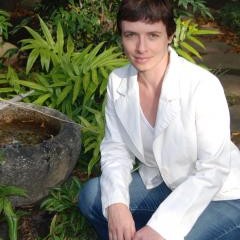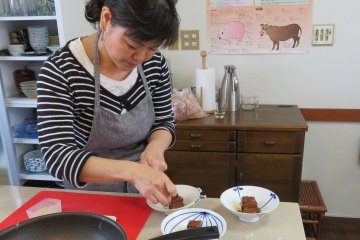Kazumi Kayo is a well-known expert in Okinawa cooking. Her expertise and skills are highly sought-after and she feature often on TV and in magazines. We explained about her background in Okinawa Cooking at Yonner Food (Part 1). Now it is time to get hands-on and do some cooking. It is a great privilege to learn from this expert at her own cooking studio.
Her classes start with a visit to Naha's Makishi Food Market to source the freshest ingredients.
Yonner Food Cooking Studio is set up in Kazumi Kayo’s apartment in the center of Naha City. A large open plan kitchen invites participants in her classes to get into action, but first Kazumi explains what will be cooked.
It is difficult to concentrate on the explanations as the cup of hibiscus tea set on the table is a visual delight. The pink color of the tea and the dried flower petals that swirl around are beautifully presented.
Prior to class, Kazumi had already prepared some of the ingredients, such as the soup stock and the pork meat.
She explains that there is a special way of how to prepare the pork: Okinawans boil the pork only partly, then drain the water, and boil the meat again, but this time for a long time, about 2 or 3 hours. The draining of liquid removes excess fat, and the long boiling of the meat makes it tender and brings out the flavor.
With an apron tied around our waists, everybody is ready to follow her easy to understand instructions. Step by step she explains what to do, and then everyone who attends has a go at cutting vegetables and tofu, putting them in pots and pans and stirring them over the fire.
Cooking takes 1.5 to 2 hours. Cooking food slowly, Kazumi says, is key in preparing healthy Okinawan food. There is no fast food in traditional Okinawan cuisine.
Finally there is another treat to prepare: goya juice made of goya, syrup, water and some drops of Okinawan lime. Delicious!
Then it is time to taste what we cooked. Well presented in small bowls and set out on the kitchen table, we savour each morsel of food. Eating slowly and chewing well is part of the secret for healthy eating.
If you signed up for the Standard Course, you will prepare four typical Okinawan dishes:
- Rafute: soft-simmered pork belly. It is simmered in a mix of bonito stock, sugar and Awamori, the local Okinawan alcohol, with soy sauce added while simmering.
- Goya champuru: stir-fried bitter melon. The ingredients are boiled pork belly, goya, carrot, onion and egg.
- Asa jiru: sea lettuce soup. You need bonito stock, asa seaweed and Okinawa tofu for this dish.
- Kufa jushi: Okinawan rice cooked with meat and vegetables, containing small pieces of boiled pork belly, shiitake mushrooms and carrots.
All in all, it takes 2 to 3 hours to complete the Standard Course. One can choose to start at 10am and eat the meal for lunch, or start at 5pm and have it for dinner.
The package includes the tour through Makishi Public Market, guided by Kazumi, ingredients and instructions, as well as the cooking and eating.
There are also a Premium Course and a Cake Course!
What are you waiting for? Cook yourself healthy!











